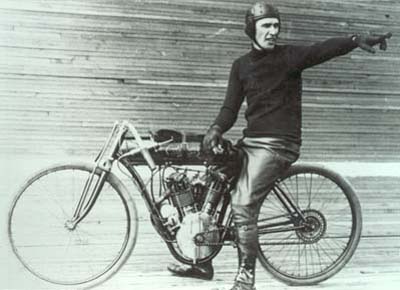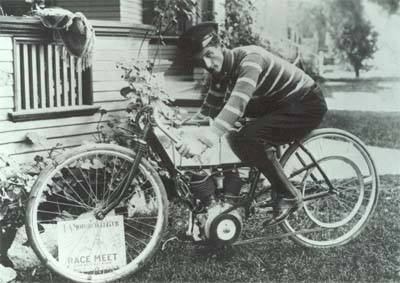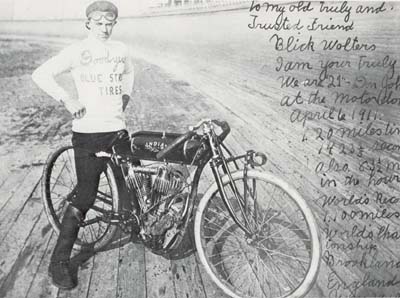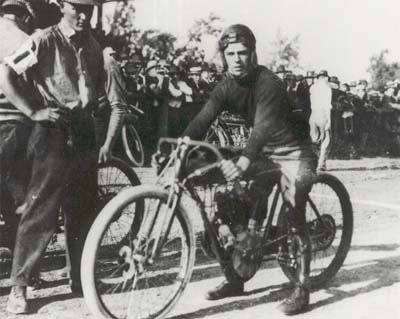by Daniel K. Statnekov |
| ©1998 - 2006 Daniel K. Statnekov |
|
Although the Cyclone was never in contention in the marketplace,
it was always a contender on the race track. In its brief appearance
on the American race scene, the distinctive, bright yellow (although
it was sometimes painted a dark, royal blue) machine with its
sophisticated, overhead-cam design, probably aroused more
curiosity and excitement than any other motorcycle in the
history of American racing.
The overhead-cam Cyclone motor that caused the excitement was designed by Andrew Strand, a Swedish-born engineer who, before joining the Joerns Motor Manufacturing Company of St. Paul, Minnesota, had worked in the American automotive industry. Prior to designing the Cyclone engine, Strand's experience included working at both the Welch and Jackson automobile companies, two firms whose automobiles featured overhead-cam engines.
In 1914, the Cyclone made its first major appearance at a Labor Day
race meet in California where the speedster from St. Paul won both
the 5 and 10-mile National Championships. The following month, J. A.
"Jock" McNeil turned a mile at the Omaha, Nebraska motordrome in
35 and 2/5th seconds (101 mph) to break the landmark Excelsior-held
record that had been established by Lee Humiston in 1912.
In a follow up speed test, McNeil traveled a mile at slightly better than 111 mph, but the official sanctioning organization refused to recognize the higher speed, suspicious that it was too high to be true. Nevertheless, the reputation of the overhead-cam speedster continued to grow, fueled by its spectacular performance in short distance dirt track events. In the few instances when the Cyclone did appear in prominent long distance race programs (such as the April, 1915 Venice 300-miler), it suffered from mechanical failures, leaving many fans unconvinced. Although Don Johns was a front runner and established a new track record at Dodge City in 1915, both he and the other Cyclone entry were forced (again by mechanical failures) to retire from the prestigious event.
Don Johns and the Cyclone had a destiny to fulfill. Born in Topeka, Kansas in 1895, Donald Johns was the son of Welsh immigrants who retired from farming and moved to Los Angeles in 1900. As a youth, Johns' parents taught him an especially rugged, self-reliant form of democracy and the boy grew up to be as strong a "fighter" in his profession as his contemporary, Jack Dempsey, the Colorado prize-fighter. As chance would have it, the Johns' family home was almost across the street from where C.W. Risden opened his pioneer Indian agency, which became the "hang-out" for all the boys in that Los Angeles neighborhood. From the very beginning, the young Johns was a fixture in Risden's shop. He spent every free moment waiting for the slightest chance to assist any motorcyclist who drove in. No task was too menial as long as it would serve as an excuse to "bum a ride." Sometimes the older motorcyclists would let him and sometimes, not, but over a period of time the "little fellow" (for Johns was only about 60 pounds then) learned to ride the motorized two wheelers. In later years, the legendary racer reminisced that when he first learned to ride he was so small that he had to climb a step ladder to get on the machine. By the time he was 12, Johns was ready to race, but the official sanctioning organization of the day ruled that he was too young to compete.
In 1907, at a competition held at the old Agricultural Park
1-mile track, the disappointed boy stood on the sidelines and watched
Charles Balke win the first novice race of the day on the machine that
had been initially prepared by Risden for Johns to ride. In a
follow-up race on the same day, "Skinny," (Mile-a-Minute) Collins,
the president of the Los Angeles Motorcycle Club, earned the nickname
that he would carry for life when he rode his 5-hp twin Peugeot around the
1-mile horse track in one minute, the first time the feat had been accomplished.
Johns bided his time, learning at his own pace and developing his own riding style. When Jake DeRosier came to Los Angeles in 1909, Johns immediately attached himself to the famous rider, volunteering to assist him in any way possible. The 29-year old DeRosier took a liking to the enthusiastic 14 year-old, and on several occasions coached him in racing techniques. Charles Balke also tutored the teenager and in later years Johns admitted learning more from "The Fearless One" than anyone else. When Johns was finally allowed to compete he was already enormously skilled and ready for the toughest competition. In August of 1909, he rode his first race in San Bernardino on his 30.50 cubic inch Thor and won the 5, 10, and 25-mile "strip-stock" class. With constant practice, Johns became a well-seasoned competitor and throughout 1910 won most of the amateur events that he entered.
On April 7, 1911, the 16 year-old Don Johns, riding a standard-valve Indian,
burst into the national headlines when he shattered all amateur records
from 2 to 20-miles. In the process, he tied Ray Seymour's professional
record for the mile and broke the world record for the 2-mile distance.
From that time on he was known as the "man to beat" wherever he
raced, and the old-timers who knew him and raced against him agreed
that if he wasn't the greatest dirt track racer of his time, and perhaps of
all time, there never was anybody around who could prove otherwise.
In those days, racing was not a gentlemanly sport. It was a rough-and-tumble affair, full of flying fists, elbows, and consequently teeth. The crowd paid to see a brawl as much as a race, and Los Angeles boasted that the western riders were the roughest of the lot. To the riders of the day, the "brawl" of racing was just part of the game. So when Johns, 16-years old, weighing around ninety pounds, and standing about four-feet ten-inches tall, was beating the Los Angeles crew of hard-fighting competitors such as Morty Graves, Charles Balke, Ray Seymour, and "Crazy Horse" Verrill, it is apparent that his stock of courage and grit was more than adequate. In 1912, at the Hawthorne track near Chicago, Johns won the 2-mile national dirt track championship uncontested. He had battled out nine firsts in that same meet against stiff competition; by the time the 2-mile event came up, no one would race against him. Continuing with Excelsior, the nationally-acclaimed rider set an official world record for the mile on the Playa del Rey board track. Despite a wind that "would snatch the fillings from your teeth," Johns turned a 39 and 2/5th-second time for the distance, replacing his former mentor, Jake DeRosier, as the title holder. Mostly though, Don Johns preferred to barnstorm the 1-mile dirt track circuits of California and the Midwest, gaining experience as well as a reputation as the "hardest fighting" rider in the "no-holds-barred" game. By 1914, Johns had improved to such an extent that the Excelsior could not hold him. He would ride the entire race course wide open, throwing great showers of dirt into the air at each turn. Often, his machine would disintegrate under him. At the 1914 Dodge City race, Johns competed with the much faster Indian 8's that had been entered by the Springfield factory to dismantle the competition. At about the 70-mile point most of the components on Johns' Excelsior had come loose, even his gas tank fell off.
So when the Joerns Company offered him a job (after the Dodge City
race) to introduce the new Cyclone on the dirt tracks, Johns accepted.
He debuted the bike at the 1914 Labor Day races in Stockton, California
and chewed up the competition, including the Indian 8's. In
the process he won both the 5 and 10-mile Championships and beat the
track record held by his recently deceased mentor, Charles Balke. Johns'
performance threw the crowd into such a frenzy that after the race they
almost tore his machine apart to take home souvenirs.
The Cyclone held up better under Johns' violent riding, but he still rode beyond the machine's capacity. News clippings from all over the United States bulge with frantic adjectives trying to describe Johns' wide-open style of riding the "speed demon" Cyclone. The meet at the Phoenix State Fair in November of 1914 is especially interesting. With a great amount of flurry and publicity, the trade papers discussed the upcoming meet in which $1,000.00 was offered for the fastest mile of the day whether by a "horse, airplane, or baby buggy." By virtue of having won the Los Angeles to Phoenix race, Barney Oldfield had been declared the "champion driver of the world." Oldfield also held the Phoenix track record at 48 seconds and was so sure that no one could beat it that he bet a local man that neither Johns nor anyone else could better 47 seconds. Furthermore, Oldfield wagered, if anyone did beat 47 seconds, then he would beat the new record. The pioneer aviator, Lincoln Beachey, flying an airplane powered by a Curtiss V-8 engine, was one entry and Don Johns on his bright yellow, overhead-cam speedster was another. Oldfield watched pop-eyed while Johns hurled the Cyclone around the track in a record shattering 46 seconds. Beachey was far behind at around 50 seconds. The "champion driver of the world" was at the wheel of a 300-horsepower front-wheel drive, 4-cylinder Christie, but even with massive amounts of brute horsepower available to him, Oldfield could not match his previous record. His best time turned out to be 48 and 4/5th seconds, and he lost both of his bets. Don Johns was in his glory and the Cyclone had prevailed. In 1915, mechanical failures sidelined all of the Cyclone entries in both of the important long distance road races (Venice, California and Dodge City) held that year. Suffering yet another breakdown at a Sacramento race in late July, Don Johns abandoned the St. Paul company and signed up to ride for Indian.
Unfortunately, the Cyclone's innovative engine design and exceptional speed
did not insure its survival. The motorcycle proved to be too expensive to
build and sell at a competitive price, and the management of the Joerns' firm
was unwilling to underwrite further development. By the end of 1915, production
was halted, but in Andrew Strand's grand attempt....a legend had been born.
|
|
|
|
|
|
Webmaster: daniels@statnekov.com |
Page installed: Nov. 15, 1996 Page revised: June 28, 2003 |



